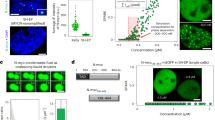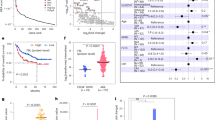Abstract
BCR–ABL oncogene, the molecular hallmark of chronic myelogenous leukemia, arises in a primitive hematopoietic stem cell that has the capacity for both differentiation and self-renewal. Its product, Bcr–Abl protein, has been shown to activate signal transducers and activators of transcription 3 (STAT3) and to promote self-renewal in embryonic stem (ES) cells, even in the absence of leukemia inhibitory factor (LIF). MEK kinase 1 (MEKK1) is a 196-kDa mitogen-activated protein kinase (MAPK) kinase kinase involved in Bcr–Abl signal transduction. To investigate the role of MEKK1 in Bcr–Abl-induced transformation of stem cells, p210 Bcr–Abl was stably transfected into wild-type (WTp210) and MEKK1−/− (MEKK1−/−p210) ES cells. Bcr–Abl enhanced MEKK1 expression in ES transfectants, as it does in other Bcr–Abl-transformed cells. In the absence of LIF, WTp210 cells showed constitutive STAT3 activation and formed rounded, compact colonies having strong alkaline phosphatase activity, a characteristic phenotype of undifferentiated ES cells. MEKK1−/−p210 cells, by contrast, showed less STAT3 activity than WTp210 cells and formed large, flattened colonies having weak alkaline phosphatase activity, a phenotype of differentiated ES cells. These results indicate that MEKK1 plays a key role in Bcr–Abl-induced STAT3 activation and in ES cells’ capacity for LIF-independent self-renewal, and may thus be involved in Bcr–Abl-mediated leukemogenesis in stem cells.
This is a preview of subscription content, access via your institution
Access options
Subscribe to this journal
Receive 50 print issues and online access
$259.00 per year
only $5.18 per issue
Buy this article
- Purchase on Springer Link
- Instant access to full article PDF
Prices may be subject to local taxes which are calculated during checkout






Similar content being viewed by others
References
Burdon T, Smith A and Savatier P . (2002). Trends Cell Biol., 12, 432–438.
Coppo P, Dusanter-Fourt I, Millot G, Nogueira MM, Dugray A, Bonnet ML, Mitjavila-Garcia MT, Le Pesteur D, Guilhot F, Vainchenker W, Sainteny F and Turhan AG . (2003). Oncogene, 22, 4102–4110.
Decker T and Kovarik P . (2000). Oncogene, 19, 2628–2637.
Deininger MW, Goldman JM and Melo JV . (2000). Blood, 96, 3343–3356.
Druker BJ . (2002). Oncogene, 21, 8541–8546.
Fanger GR, Johnson NL and Johnson GL . (1997). EMBO J., 16, 4961–4972.
Hagemann C and Blank JL . (2001). Cell Signal., 13, 863–875.
Hirano T, Ishihara K and Hibi M . (2000). Oncogene, 19, 2548–2556.
Holyoake T, Jiang X, Eaves C and Eaves A . (1999). Blood, 94, 2056–2064.
Lim CP and Cao X . (2001). J. Biol. Chem., 276, 21004–21011.
Nawata R, Yujiri T, Nakamura Y, Ariyoshi K, Takahashi T, Sato Y, Oka Y and Tanizawa Y . (2003). Oncogene, 22, 7774–7780.
Ogihara T, Shin BC, Anai M, Katagiri H, Inukai K, Funaki M, Fukushima Y, Ishihara H, Takata K, Kikuchi M, Yazaki Y, Oka Y and Asano T . (1997). J. Biol. Chem., 272, 12868–12873.
Okamoto H, Takuwa N, Yokomizo T, Sugimoto N, Sakurada S, Shigematsu H and Takuwa Y . (2000). Mol. Cell. Biol., 20, 9247–9261.
Pease S, Braghetta P, Gearing D, Grail D and Williams RL . (1990). Dev. Biol., 141, 344–352.
Sadowski HB, Shuai K, Darnell Jr JE and Gilman MZ . (1993). Science, 261, 1739–1744.
Simon AR, Vikis HG, Stewart S, Fanburg BL, Cochran BH and Guan KL . (2000). Science, 290, 144–147.
Skorski T, Wlodarski P, Daheron L, Salomoni P, Nieborowska-Skorska M, Majewski M, Wasik M and Calabretta B . (1998). Proc. Natl. Acad. Sci. USA, 95, 11858–11862.
Yujiri T, Sather S, Fanger GR and Johnson GL . (1998). Science, 282, 1911–1914.
Acknowledgements
We thank Drs Owen N Witte and Yoh Takuwa for the generous gift of plasmids. We also thank Drs Takumi Era (RIKEN), Keisuke Hagihara, and Kazuyuki Yoshizaki (Osaka University) for valuable discussions; Yukari Kora and Atsuko Tanimura for technical assistance. This work was supported by a grant-in-aid from the Ministry of Education, Culture, Science and Sports of Japan (to TY).
Author information
Authors and Affiliations
Corresponding author
Rights and permissions
About this article
Cite this article
Nakamura, Y., Yujiri, T., Nawata, R. et al. MEK kinase 1 is essential for Bcr–Abl-induced STAT3 and self-renewal activity in embryonic stem cells. Oncogene 24, 7592–7598 (2005). https://doi.org/10.1038/sj.onc.1208899
Received:
Revised:
Accepted:
Published:
Issue Date:
DOI: https://doi.org/10.1038/sj.onc.1208899
Keywords
This article is cited by
-
Combating acquired resistance to MAPK inhibitors in melanoma by targeting Abl1/2-mediated reactivation of MEK/ERK/MYC signaling
Nature Communications (2020)
-
BAALC potentiates oncogenic ERK pathway through interactions with MEKK1 and KLF4
Leukemia (2015)
-
Map3k1
AfCS-Nature Molecule Pages (2010)



